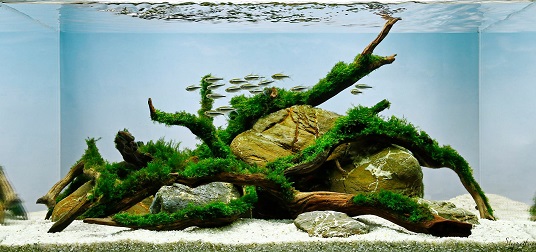When asked what I do for a living by a non-fishkeeper I will usually say, “I make fish tanks look pretty.”
The term aquascaper is then introduced, and I’ll describe it as landscape gardening, but in a glass box with aquatic plants and natural décor. I explain that the aquarium is the canvas. The plants, rocks, wood and fish are the paint. We are the artist with the paintbrush.
Aquariums and aquascaping as an art form is a foreign concept to many, and some folk still have the perception that fish tanks have to be filled with coloured gravel and tacky ornaments. It’s my mission to change that.
For me, aquascaping is the ultimate art form. It’s a three-dimensional, constantly evolving (if live plants or corals are used), living sculpture and slice of nature that brings a sense of tranquility and well-being to any interior space.
The entire process is a joy: the excitement of planning the set-up and aquascape design, planting, maintenance, and watching the aquascape mature. When compared with aquascaping with artificial décor, the sense of gratification runs so much deeper.
In my future online articles, I intend to cover all aspects of aquascaping: definitions and concepts, choosing equipment, hardscape selection and positioning, planting, maintenance, photography, and aquascaping contests. You can expect lots of hints and tips, too!
If there’s any particularly aspects you’d like me to cover, then please let me know.
Photo and video credit: George Farmer







Always love to hear from someone who’s results speak such volumes! Currently I’m grappling with what is and isn’t possible in terms of keeping the more vulgar species of algae out of my tanks. It’s a bit like keeping out a viral infection I’m finding? Good quarantine, bleach baths? How often do you have to tear apart and sterilize a tank because its become infested with some nasty beard algae?
Hi Jesse
Thank you.
With algae prevention is better than cure. By focusing on growing healthy plants we can prevent algae. Excess light and too much organic waste build-up is usually to blame for most forms of algae.
In non-planted tanks then lighting should be limited as much as possible. Limiting nitrates and phosphates in a non-planted tank will help, but these nutrients are required in a planted tank.
You should never have to sterilize the complete tank but removing individual items of decor and dealing with them is an option.
I hope that helps.
I’d love to hear about equipment sourcing during the planning phase. Where, what type, sources for various components, do-it-yourself projects that can be used to accomplish the same as purchased items reliably would be great topics.
Cheers!
I am just getting into aquariums again and am trying planted tanks but so far I seem to grow algae the best. So I too would like to learn more about the best way to try to prevent algae and how to deal with it when it does show up. I also like Wade’s ideas on subjects to cover. I don’t have much of an income so do-it-yourself projects that actually work well would be nice. Thanks for these helpful articles and I am looking forward to reading more from you!
Great site lot’s of great information, thanks!!